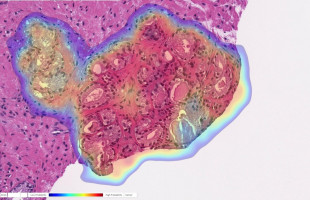
A study published in The Lancet Digital Health by UPMC and University of Pittsburgh researchers demonstrates the highest accuracy to date in recognising and characterising prostate cancer using an artificial intelligence (AI) program.
"Humans are good at recognising anomalies, but they have their own biases or past experience," said senior author Rajiv Dhir, M.D., M.B.A., chief pathologist and vice chair of pathology at UPMC Shadyside and professor of biomedical informatics at Pitt. "Machines are detached from the whole story. There's definitely an element of standardising care."
To train the AI to recognise prostate cancer, Dhir and his colleagues provided images from more than a million parts of stained tissue slides taken from patient biopsies. Each image was labeled by expert pathologists to teach the AI how to discriminate between healthy and abnormal tissue.
The algorithm was then tested on a separate set of 1,600 slides taken from 100 consecutive patients seen at UPMC for suspected prostate cancer.
During testing, the AI demonstrated 98% sensitivity and 97% specificity at detecting prostate cancer - significantly higher than previously reported for algorithms working from tissue slides.
Also, this is the first algorithm to extend beyond cancer detection, reporting high performance for tumour grading, sizing and invasion of the surrounding nerves.
These all are clinically important features required as part of the pathology report.
AI also flagged six slides that were not noted by the expert pathologists.
But Dhir explained that this doesn't necessarily mean that the machine is superior to humans.
For example, in the course of evaluating these cases, the pathologist could have simply seen enough evidence of malignancy elsewhere in that patient's samples to recommend treatment.
For less experienced pathologists, though, the algorithm could act as a failsafe to catch cases that might otherwise be missed.
"Algorithms like this are especially useful in lesions that are atypical," Dhir said. "A nonspecialized person may not be able to make the correct assessment. That's a major advantage of this kind of system."
While these results are promising, Dhir cautions that new algorithms will have to be trained to detect different types of cancer.
The pathology markers aren't universal across all tissue types.
But he didn't see why that couldn't be done to adapt this technology to work with breast cancer, for example.
Source: University of Pittsburgh
Image: Ibex Medical Analytics
We are an independent charity and are not backed by a large company or society. We raise every penny ourselves to improve the standards of cancer care through education. You can help us continue our work to address inequalities in cancer care by making a donation.
Any donation, however small, contributes directly towards the costs of creating and sharing free oncology education.
Together we can get better outcomes for patients by tackling global inequalities in access to the results of cancer research.
Thank you for your support.